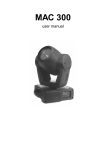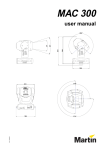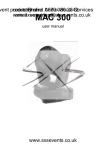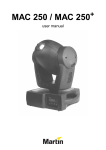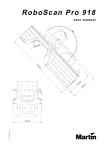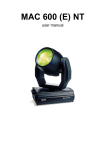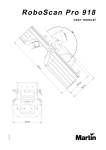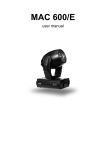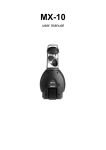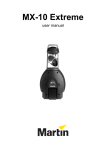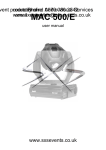Download Martin MAC 300 User manual
Transcript
MAC 300 user manual table of CONTENTS Introduction ..........................................................................................................3 Lamp Installation..................................................................................................5 AC Power Connection..........................................................................................6 Data Connection...................................................................................................7 Rigging ..................................................................................................................8 Fixture Settings ....................................................................................................9 Operation ............................................................................................................15 Basic Service ......................................................................................................17 Troubleshooting .................................................................................................21 DMX Protocol......................................................................................................22 Error Messages ..................................................................................................24 PCB Layout .........................................................................................................25 Accessories ........................................................................................................26 Specifications .....................................................................................................27 ©1999 - 2000 Martin Professional A/S, Denmark. All rights reserved. No part of this manual may be reproduced, in any form or by any means, without permission in writing from Martin Professional A/S, Denmark. Printed in Denmark. P/N 35000075, Rev. C. section 1 INTRODUCTION Thank you for selecting the Martin MAC 300. The MAC 300 is an automated yoke-mounted Fresnel washlight employing a 250 watt discharge lamp. It provides cyan, magenta, and yellow (CMY) color mixing, separate color wheel with 6 replaceable dichroic filters, variable frost, strobe effects, full-range dimming, and accurate 16-bit movement. Efficient optics, attractive design, modular construction and numerous other features make the MAC 300 well suited for any lighting application calling for color mixing and soft focus in a 250 watt fixture. M AC 3 0 0 s a f e t y i n fo r m a t i o n WARNING! This product is for professional use only. It is not for household use. This product presents risks of lethal or severe injury due to fire and heat, electric shock, ultraviolet radiation, lamp explosion, and falls. Read this manual before powering or installing the fixture, follow the safety precautions listed below and observe all warnings in this manual and printed on the fixture. If you have questions about how to operate the fixture safely, please contact your Martin dealer or call the Martin 24-hour service hotline at +45 70 200 201. To p r o t e c t y o u r s e l f a n d o t h e r s f r o m e l e c t r i c s h o c k • Disconnect the fixture from AC power before removing or installing the lamp, fuses, or any part, and when not in use. • Always ground (earth) the fixture electrically. • Use only a source of AC power that complies with local building and electrical codes and has both overload and ground-fault protection. • Do not expose the fixture to rain or moisture. • Refer any service operation not described in this manual to a qualified technician. To p r o t e c t y o u r s e l f a n d o t h e r s f r o m U V r a d i a t i o n a n d l a m p e x p l o s i o n • Never operate the fixture with missing or damaged lenses and/or covers. • When replacing the lamp, allow the fixture to cool for at least 5 minutes before opening the fixture or removing the lamp. Protect your hands and eyes with gloves and safety glasses. • Do not stare directly into the light. Never look at an exposed lamp while it is lit. • Replace the lamp if it becomes defective or worn out, or before usage exceeds 125 percent of the rated average life. To p r o t e c t y o u r s e l f a n d o t h e r s f r o m b u r n s a n d f i r e • Never attempt to bypass the thermostatic switch or fuses. Always replace defective fuses with ones of the specified type and rating. • Keep all combustible materials (for example fabric, wood, paper) at least 0.4 meters (16 inches) away from the fixture. Keep flammable materials well away from the fixture. • Do not illuminate surfaces within 0.4 meters (16 inches) of the fixture. • Provide a minimum clearance of 0.1 meters (4 inches) around fans and air vents. • Never place filters or other materials over the lens. • The exterior of the fixture can reach temperatures up to 150° C (302° F). Allow the fixture to cool for at least 5 minutes before handling. • Do not modify the fixture or install other than genuine Martin parts. • Do not operate the fixture if the ambient temperature (Ta) exceeds 40° C (104° F). To p r o t e c t y o u r s e l f a n d o t h e r s f r o m i n j u r y d u e t o f a l l s • When suspending the fixture above ground level, verify that the structure can hold at least 10 times the weight of all installed devices. • Verify that all external covers and rigging hardware are securely fastened and use an approved means of secondary attachment such as a safety cable. • Block access below the work area whenever installing or removing the fixture. Introduction 3 Unpacking The MAC 300 comes with: • • • • 1 1/4-turn clamp mounting bracket 1 5-meter, 3-pin shielded XLR control cable 1 3-meter, 3-wire IEC power cable 1 user manual The packing material is carefully designed to protect the fixture during shipment - always use it or a custom flight case to transport the fixture. Main dimensions 4 Introduction section 2 LAMP INSTALLATION This section describes how to install a lamp. Compatible lamps The lamps listed in the table below may be used with the MAC 300. Installing any other lamp may damage the fixture. Replace before Average life Color Temp. Output P/N Osram HSD 250 2500 hr. 2000 hr. 6000K 68 lm/W 97010103 Philips MSD 250/2 2200 hr. 2000 hr. 6500K 72 lm/W 97010100 Philips MSD 200 2200 hr. 2000 hr. 5600K 67 lm/W 97010106 Lamp Installing or changing the lamp WA R N I N G ! Always disconnect the fixture from AC power and allow it to cool before installing the lamp. To protect against lamp explosion, allow a hot lamp to cool for at least 5 minutes before removing the lamp socket. reflector alignment screws lamp socket assembly Figure 1: Lamp installation 1. Remove the 2 Phillips screws from the lamp socket assembly. Pull the lamp and socket out of the head. 2. Remove the old lamp, if any, from the socket. 3. Holding the new lamp by its ceramic base (do not touch the glass), align the small pin with the small hole and insert the lamp squarely into the socket. Make sure that the 4 small projections on the base contact the face of the socket. 4. Clean the glass bulb with the cloth supplied with the lamp, particularly if your fingers touched the glass. A clean, lint-free cloth wetted with alcohol may also be used. 5. Gently insert the assembly, making sure the lamp fits through the opening in the reflector. Replace the 2 screws. 6. Please see “Optimizing reflector alignment” on page 19 to optimize light output. Lamp Installation 5 section 3 A C PO W E R C O N N E C T I O N This section describes how to tap the power supply for local conditions and how to wire the mains lead. Do not connect the MAC 300 to an electrical dimmer system: doing so can damage the electronics. WA R N I N G ! For protection from dangerous electric shock, the fixture must be grounded (earthed). The AC supply shall have overload and ground-fault protection. C h a n g i n g vo l t ag e a n d f r e q u e n cy s e t t i n g s The factory settings are printed on the serial number label under the base. These settings must match the local AC power supply as closely as possible! Operating at the incorrect power setting can result in poor light output, greatly reduced lamp life, overheating and/or damage to the fixture. 1. Disconnect the fixture from AC power. Unscrew and remove the cover from top of the base on the side closest to the power inlet. 2. Locate the 7-terminal connection block. Move the wires to the terminals that most closely match local conditions as shown in Table 1. If the local voltage falls halfway between settings, use the higher voltage setting. For example, use the 120 V setting if your voltage is 110 V. 3. Replace the cover. 100 V 50 Hz 60 Hz 0V 20 V 120 V 230 V 250 V 60 Hz 50 Hz 0V 20 V 120 V 230 V 250 V 60 Hz 50 Hz BLUE BROWN BLACK BLUE BROWN BLACK 120 V BLUE 0V 20 V 120 V 230 V 250 V 60 Hz 50 Hz BROWN BLACK BLUE 0V 20 V 120 V 230 V 250 V 60 Hz 50 Hz BROWN BLACK 210 V 0V 20 V 120 V 230 V 250 V 60 Hz 50 Hz 0V 20 V 120 V 230 V 250 V 60 Hz 50 Hz 230 V BLUE BROWN BLACK BLUE BROWN BLACK 0V 20 V 120 V 230 V 250 V 60 Hz 50 Hz 0V 20 V 120 V 230 V 250 V 60 Hz 50 Hz BLUE BROWN BLACK BLUE BROWN BLACK 250 V 0V 20 V 120 V 230 V 250 V 60 Hz 50 Hz 0V 20 V 120 V 230 V 250 V 60 Hz 50 Hz BLUE BROWN BLACK BLUE BROWN BLACK Table 1: Voltage and frequency settings Wiring the mains lead Wire Pin Marking Screw (US) brown live “L” yellow or brass blue neutral “N” silver yellow/green ground green Table 2: Cord cap wiring 6 1. Install a grounding-type cord cap on the mains lead. Connect the yellow/green wire to ground (earth), the brown wire to live (hot), and the blue wire to neutral. Table 2 shows some possible pin identification schemes; if you have any doubts about proper installation, consult a qualified electrician. 2. Verify that the feed cable is undamaged and rated for the current requirements of all connected devices. AC Power Connection section 4 DATA CONNECTION This section describes how to connect fixtures to a controller. The MAC 300’s 3-pin XLR connectors are configured for use with DMX-512 controllers. To reconfigure them for use with Martin Protocol controllers, see “Changing the XLR pin-out” on page 19. XLR PIN-OUT Pin 1: shield Pin 2: signal - Pin 3: signal + Recommended cable Use cable designed for RS-485 devices with low capacitance and a characteristic impedance of 85 to 150 ohms. The cable must be electrically shielded and have at least 1 pair of twisted wires. The minimum wire size is 0.2 mm2 (24 AWG) for runs up to 300 meters (1000 ft.), and 0.322 mm2 (26 AWG) for runs up 500 meters (1640 ft.). Adaptors As many devices have 5-pin connectors and others have 3-pin connectors with reversed signal polarity, adaptor cables as shown below may be required. Insert a termination plug in the output of the last fixture on the link. 5-pin to 3-pin Adaptor 3-pin to 5-pin Adaptor 3-pin to 3-pin Phase-Reversing Adaptor Termination Plug Male Female Male Female Male Female Male 1 2 3 4 5 1 2 3 1 2 3 1 2 3 4 5 1 2 3 1 2 3 1 2 3 P/N 11820005 Construct P/N 11820006 120 P/N 91613017 Figure 2: Cable adaptors and termination Building the data link 1. DMX controllers: Connect a data cable to the controller’s data output. If controller has a 5-pin female socket, use a 5-pin male to 3-pin female adaptor cable (P/N 11820005). Martin RS-485 protocol controllers: First, connect a 3-pin “swapper” cable (P/N 11820006) to the controller’s data output; then, connect a regular data cable to the swapper cable. Alternatively, reconfigure the XLR pin-out as described on page 19. 2. If convenient, you may split the link into branches using a splitter such as the Martin 4-Channel Opto-Isolated RS-485 Splitter/Amplifier. Do not use a “Y” connector to split the link. 3. Lead the data cable from the controller to the first fixture. Plug the cable into the fixture’s data input socket. 4. Connect the output of the fixture closest to the controller to the input of the next fixture. If connecting to another type of fixture with reversed-polarity (pin 3 cold), insert a swapper cable between the two fixtures. 5. Continue connecting fixtures output to input. Up to 32 devices may be connected on a serial link. If more fixtures are required, use another controller output, if available, or an RS-485 amplifier. 6. Terminate the link by inserting a male termination plug (P/N 91613017) into the data output of the last fixture. A termination plug is simply an XLR connector with a 120 ohm, 0.25 W resistor soldered across pins 2 and 3. If a splitter is used, each branch of the link must be terminated. Data Connection 7 section 5 RIGGING This section briefly describes how to install the MAC 300 on a truss. Location and orientation The MAC 300 may be installed in any orientation. It shall be located at least 0.4 meters (16 inches) away from the surface to be illuminated and any combustible materials. The lamp socket at the back of the head reaches temperatures up to 150° C (302° F): the fixture should not be located in publicly trafficked areas. Rigging hardware The MAC 300 includes a clamp mounting bracket to which 1 or 2 rigging clamps (not included) can be bolted with locking 12 mm (1/2 in.) hardware. The clamp bracket fastens to the base with 1/4-turn fasteners. For clamps available from Martin, see the list of accessories on page 26. Figure 3: Clamp mounting bracket To h a n g t h e f i x t u r e o n a t r u s s WA R N I N G ! Block access below the work area before proceeding. Always fasten a safety cable to the reinforced attachment point in the base. The 1/4-turn fasteners are locked only when turned fully clockwise. 8 1. Verify that the clamps are in good condition and can bear at least 10 times the weight of the fixture. Bolt clamps to the bracket with a grade 8.8 (minimum) M12 bolt and lock nut, or as recommended by the clamp manufacturer, through the 13 mm holes in the clamp mounting bracket. 2. Align the clamp mounting bracket with any 2 key slots on the base. Insert both locking pins into the slots and turn both levers a full 1/4 turn clockwise to lock. 3. Verify that the structure can bear at least 10 times the weight of all installed fixtures, clamps, cables, auxiliary equipment, etc. 4. Working from a stable platform, clamp the fixture to the structure. 5. Install a safety cable that can bear at least 10 times the weight of the fixture securely to the structure and anchor the cable to the dedicated attachment point in the base. The attachment point is designed to fit a carabiner clamp. Rigging section 6 FIXTURE SETTINGS This section describes how to set the address and personalities, read lamp hours, DMX values, and other information; calibrate effects, control the fixture manually, and run test and demo programs from the 4-digit LED control panel. Functions that do not require feedback can also be performed remotely via the serial link using the MPBB1 Uploader. Please refer to the MPBB1 manual. Menu navigation The DMX or Martin address, depending on the mode, and any error messages are displayed after the MAC 300 resets. To enter the menu, press [MENU]. Use the [↑] and [↓] keys to move within the menu. To select a function or submenu, press [Enter]. To escape, press [MENU]. Address/ Messages AddR PSET PERS INFO TEST UTIL MAN AdJ DMX MOdE PATI HRS TSEQ UPLd RST RST SWAP PINV TINV TOTL RSET DMXL dEMO L ON L ON MINP MAXP MINT MAXT GO LOFF LOFF L HR STCO SHUT ... E SP SHUT FEbA dIM HEAd MART AUTO PTSP dLOF TOTL RSET PCb dRES L ST ALON TOTL RSET dISP dINT dMOd VER CYAN FACT MAG ETST MTST STST CPU FEbA dISP SCUT YEL dIM COL CYAN MAG YEL FROS COL PATI FROS CAL PAN EFFb TILT TRAC MOdE CAL P OF T OF d OF C OF M OF Y OF dFOF dFSE FACT CUS1 CUS2 CUS3 Figure 4: MAC 300 menu Fixture Settings 9 Pe rs o n a l i t y s e t t i n g s The MAC 300’s personality settings are shown in Table 3; they are described as well in the following section. To select a personality setting: 1. Press [Menu] as required to reach the main menu. Navigate to PE RS and press [Enter]. 2. Navigate to the desired setting and press [Enter]. 3. Select the desired option with the arrow keys and press [Enter]. Personality Path Pan/tilt swap PATI /SW AP Pan inverse Options Effect (Default setting shaded, * indicates DMX override) ON Map DMX pan control to tilt channel and vice versa. OFF Normal pan and tilt control. ON Reverse DMX pan control (right Æ left). OFF Normal pan control (left Æ right). ON Reverse DMX tilt control (down Æ up). OFF Normal tilt control (up Æ down). FAS T Optimize movement for speed.* SLO W Optimize movement for smoothness.* ON Enable DMX lamp off command. OFF Disable DMX lamp off command.* ON Enable DMX reset command. OFF Disable DMX reset command.* ON Lamp strikes automatically within 90 seconds of power on. OFF Lamp remains off until “lamp on” command is sent. ON Display stays on. OFF Display goes out 2 minutes after last key press. 10 - 100 Adjust display intensity. NOR M Normal dimming. TUN G Simulated tungsten dimming. ON Color and CMY wheels turn the shortest direction.* OFF Wheels turn same direction.* ON Enable feedback on color and CMY wheels. OFF Disable feedback on color and CMY wheels. MOd 1 Absolute delta value algorithm (for most controllers) MOd 2 Real delta value algorithm 1-1 0 Tracking samples. Increase if pan/tilt is not smooth. PATI/PINV Tilt inverse PATI/TINV Pan/tilt speed PTSP DMX lamp off dLOF DMX reset dRES Automatic lamp on Display on/off ALON dISP Display intensity dINT Dimmer mode dMOd Shortcuts SCUT Effects feedback EFFb Tracking algorithm Tracking samples TRAC/MOdE TRAC/CAL Table 3: Personality settings Custom personality configurations Three sets of custom personality configurations can be stored for later recall. To create and use a custom configuration: 10 1. Set the personalities as desired. 2. Navigate to PE RS / d FSE and press [Enter]. 3. Select CUS 1 , CU S2 , or CUS 3 and press [Enter]. 4. Select SAV E to create a custom configuration or LO Ad to recall. Press [Enter]. 5. To load the factory default personality settings, navigate to PER S / dF SE / FA CT and press [Enter]. Fixture Settings Adjusting the LED display Inv er t To flip the display vertically, press the up-arrow [↑] and down-arrow [↓] keys simultaneously. Adjust intensity To adjust the display intensity, set PE RS/d INT to a level between 10 and 100. Blackout To blackout the display 2 minutes after the last key-press, toggle PER S/d ISP to O FF. Protocol selection The MAC 300 can be controlled with DMX-512 and Martin RS-485 protocol controllers. When used with DMX controllers, there are 4 control protocols to choose from. The control option - DMX mode 1, 2, 3, 4; or Martin - must match the controller setup. 1 2 3 4 5 6 7 8 9 1 2 3 4 5 6 7 8 9 10 11 1 2 3 4 5 6 7 8 9 10 11 1 2 3 4 5 6 7 8 9 10 11 12 13 shutter dimmer cyan magenta yellow color wh. frost pan coarse tilt coarse shutter dimmer cyan magenta yellow color wh. frost pan coarse pan fine tilt coarse tilt fine shutter dimmer cyan magenta yellow color wh. frost pan coarse tilt coarse p/t speed fx speed shutter dimmer cyan magenta yellow color wh. frost pan coarse pan fine tilt coarse tilt fine p/t speed fx speed DMX mode summary Mode 1 tracking control 8-bit pan/tilt 9 channels Mode 2 tracking control 16-bit pan/tilt 11 channels Mode 3 tracking & vector control 8-bit pan/tilt 11 channels Mode 4 tracking & vector control 16-bit pan/tilt 13 channels The DMX modes are summarized above. Mode 4 provides full control; it is recommended unless channels are limited. To s e l e c t a p r o t o c o l Press To [Menu] As required Display main menu [↑], [↓] As required Select PSE T [Enter] Once Display sub menu [↑], [↓] As required Select MOd E [Enter] Once Display currently selected control mode [↑], [↓] As required Select protocol (dM X1 , dMX 2 , dMX 3 , dMX 4 , M ART ) [Enter] Once Save setting. MOd E is displayed. [Menu] Once Display main menu [Menu] Once Display current address Table 4: Setting a protocol Au t o m a t i c p ro t o c o l d e t e c t i o n Automatic protocol detection allows the MAC 300 to detect the controller type - DMX-512 or Martin RS485 - and respond accordingly. If it is a DMX controller, the MAC 300 uses the control option selected above. The default setting is OFF . To turn it on, navigate to the PS ET sub menu, select AUT O , press [Enter], select ON , and press [Enter]. Fixture Settings 11 Address selection The address, also known as the start channel, is the first channel used to receive instructions from the controller. The address set on the fixture must match the address set on the controller. When selecting DMX addresses, be sure to allow the number of channels required for the protocol. If any of the control channels for one fixture overlap any of the channels for another fixture, then one of the fixtures will receive the wrong instructions and respond incorrectly. Two MAC 300s may share the same address, however, if they are to respond identically: they will receive the same instructions so individual control will be impossible. Note: Whether the MAC 300 displays a DMX or Martin address at the top of the menu depends on the protocol selected. To s e t a D M X a d d r e s s Press To [Menu] As required Display main menu [↑] As required Select Add R [Enter] Once Display address sub menu [↑] As required Select DMX [Enter] Once Display current DMX address [↑], [↓] As required Select desired DMX address [Enter] Once Save the new address. DMX is displayed. [Menu] Once Display main menu [Menu] Once Display current address for the P SET setting. Table 5: Selecting a DMX address To s e t a M a r t i n a d d r e s s The MAC 300 uses 2 Martin RS-485 channels. Press To [Menu] As required Display main menu [↑] As required Select Add R [Enter] Once Display address sub menu [↑] As required Select MAR T [Enter] Once Display current Martin address [↑], [↓] As required Select desired Martin address [Enter] Once Save the new address. MAR T is displayed. [Menu] Once Display main menu [Menu] Once Display current address for the P SET setting. Table 6: Selecting a Martin address 12 Fixture Settings Readouts The MAC 300 has counters to track usage, maintenance intervals, lamp life, etc. One set of counters shows total (TOT L ) accumulated usage and cannot be reset. Another set shows usage since the counter was reset (RS ET ). To reset one of these counters, navigate to the readout and press [↑] for 5 seconds. Hours used To read the accumulated total number of hours the fixture has been on, navigate to INF O / H RS / T OTL and press [Enter]. To read the number of hours since the counter was last reset, navigate to INF O / HRS / RS ET and press [Enter]. To reset this counter, navigate to the readout and press [↑] for 5 seconds. Lamp hours To read the accumulated total number of lamp hours, navigate to IN FO / L H R / TO TL and press [Enter]. To read the number of lamp hours since the counter was last reset, navigate to IN FO / L HR / R SET and press [Enter]. To reset this counter when installing a new lamp, navigate to the readout and press [↑] for 5 seconds. Lamp strikes To read the accumulated total number of lamp strikes, navigate to INF O / L ST / TOT L and press [Enter]. To read the number of lamp strikes since the counter was last reset, navigate to IN FO / L ST / RSET and press [Enter]. To reset this counter when installing a new lamp, navigate to the readout and press [↑] for 5 seconds. Software version Navigate to the sub menu under INF O / VE R to read the version number of the CPU software (C PU ), feedback circuit software (F EBA ), and display module software (dIS P ). Utilities Upload mode The software upload mode is engaged automatically by the MPBB1 Uploader. Engage upload mode manually only if automatic upload fails. To do so, navigate to U TIL / U PLd and press [Enter]. Press [Enter] again when S URE is displayed to confirm, or press [Menu] to escape. See also “Updating software” on page 19. Demonstration program The demonstration menu allows you to run a preprogrammed stand-alone program. Before running the demo, set the minimum and maximum pan and tilt positions (M INP, MAXP, MIN T, MAX T ) to a good location for viewing the effects. Select GO and press [Enter] to run the demo. Press [Menu] to stop the program. Te s t p r o g r a m s Te s t s e q u e n c e Navigate to TE ST / TS EQ and press [Enter] when RU N is displayed to perform a general fixture test. Press [Menu] to stop the program. DMX log The DMX log provides a quick way to check if the fixture is receiving DMX instructions correctly. The log displays the start code (STC O ), which must be 0, and the DMX values received on each control channel. To read a value, navigate to TES T / DMX L and press [Enter]. Scroll to an effect channel and press [Enter] to read the DMX value received. Look up the value’s function in the DMX protocol to see if it corresponds to the effect’s behavior. Quality control and service tests The PCB and F ACT menus, under TES T, contain tests for factory and service use. The factory effects test (TES T / FA CT / ETS T ) drives all effects at 10 percent over their maximum speed. Fixture Settings 13 Manual control The manual control menu (MA N ) permits limited operation from the control panel. • • • • • • • • To reset the fixture, select RST . To turn the lamp on or off, select L O N or LoF F. To open, close, and strobe the shutter at 3 speeds, select SHU T. To control the dimmer, select dI M . To move the color wheel to each position and scroll it at 3 speeds, select C OL . To control the CMY mix, select C YAN , MAG , and YE L . To insert the frost filter, select FR OS . To control pan and tilt, select PA N and TIL T. Adjustment control and calibration The adjustment menu (A dJ ) provides the following functions: • • • • • • Reset the fixture (R ST ) Turn on and off the lamp (L ON , Lo FF ) Disable pan/tilt feedback (FEb A ) Control effects in the head (H EAd ) Move the head to the home and extreme positions (PAT I ) Calibrate effects (CAL ) Head effects adjustment The head submenu (A dJ / HEAd ) provides manual control when making mechanical adjustments, which must be performed by a qualified technician. It allows the technician to: • • • • Open, close, and strobe the dimmer/shutter Move the color wheel to the open, sensor, and full color positions Move the CMY wheels to the open, sensor, and full positions Insert and remove the frost filter Calibration The calibration submenu (A dJ / CA L ) allows you to adjust the effects for uniformity between fixtures: it is not a substitute for mechanical adjustment. To reset all calibrations to their factory defaults, select d FOF and press [Enter] when SUR E is displayed, or press [MENU] to escape. 14 1. Select the effect to calibrate: pan (P OF ), tilt (T O F ), dimmer/shutter (d OF ), cyan (CY OF ), magenta (MA OF ), or yellow (YE OF ). 2. Calibrate the effect using the arrow keys until it matches the other units. Offsets are adjustable from 1 to 255. 3. Press [Enter] to save the calibration. Fixture Settings section 7 OPERATION This section describes the MAC 300’s controllable effects and how personality settings affect their behavior. Selecting personalities from the control panel is described in the previous section. Mar tin RS-485 con trol The MAC 300 will be controllable with the Martin 3032 controller when version 2.07 of the 3032 software is released. To respond to the controller, either Martin mode must be selected or automatic protocol detection must be enabled. DMX-512 control The MAC 300 may be operated with USITT DMX512 controllers in 4 different modes that mix vector and/or tracking control with 8-bit or 16-bit pan/tilt resolution in different combinations. Tr a c k i n g v e r s u s v e c t o r c o n t r o l With tracking control the time it takes an effect to move from one position to another is controlled by programming a fade time on the controller. The controller divides the move into steps and updates the fixture with small changes at the rate required to achieve the fade. The MAC 300 follows or “tracks” the changes, and averages them with a digital filter algorithm to ensure smooth movement at all speeds. With vector control you set the fade speed on a separate speed channel. This provides a way to fade effects with controllers that do not have programmable fade times. With controllers that send slow or irregular tracking updates, vector control provides smoother movement, particularly at slow speeds. Tracking control can be enabled in vector mode by setting one or both of the speed channels to “tracking speed.” When setting a fade speed, though, the controller fade time must be 0, i.e., the position snaps from one value to the next. Vector control also provides a special “blackout speed” and overrides of the shortcut and pan/tilt speed personality settings. 8-bit versus 16-bit pan/tilt resolution With 8-bit pan/tilt resolution, pan and tilt are divided into 256 equal increments. Finer position control and smoother movement is provided in the 16-bit modes, which divide pan into 40,192 positions and tilt into 39,424 positions. Controllable effects All mechanical effects are reset to a home position when the fixture is powered up and they can also be reset from the controller. The DMX Reset function (PE RS/ dRE S ), when set to off, prevents accidental resets by adding the requirement that each CMY channel be set to a DMX value from 230 to 232. An on-the-fly position correction system automatically corrects the position of the CMY wheels and the color wheel. Though this feature can be disabled by turning Effects Feedback (P ERS /EFF b ) off, doing so is not recommended. Lamp With the default setting, the lamp remains off until a “lamp on” command is sent from the controller. Note: A peak of electric current that can be many times the operating current is drawn for an instant when striking a discharge lamp. Striking many lamps at once may cause a voltage drop large enough to prevent lamps from striking or draw enough current to trip circuit breakers. If sending “lamp on” commands to multiple fixtures, program a sequence that strikes lamps one at a time at 5 second intervals. The MAC 300 automatically strikes the lamp within 90 seconds of being powered on only if the Automatic Lamp On setting (P ERS /AL ON ) is turned on. A delay determined by the fixture address staggers lamp strikes to prevent excessive current draw. The lamp can be turned off from the controller. Note: the lamp cannot be restruck for 8 minutes after being turned off. Accidental “lamp off” commands can be prevented by turning the DMX Lamp Off setting (PER S/d LOF ) off. Operation 15 Dimmer / shutter The mechanical dimmer/shutter system provides full, high-resolution dimming, and random or variable strobe effects up to 14 Hz. The Dimmer Mode (PER S / dMO d ) setting allows you to select between linear or simulated tungsten fade curves. For simulated tungsten dimming, the fade time must be set to 0. CMY subtractive color mixing The CMY color mixing system is based on graduated cyan, magenta, and yellow color filters. A continuous range of colors may be achieved by varying the amount of each filter from 0 to 100%. Random CMY color mixing at three speeds can be selected on DMX channel 6. The Shortcuts setting (PE RS/ SCU T ) determines whether or not the CMY wheels always take the shortest path to the next position; this setting may be overridden on the speed channel in vector mode. Color The color wheel provides a 5500 to 2900K color temperature correction (CTC) filter, a UV filter, and 4 saturated dichroic color filters. The filters are replaceable; please see “Changing color filters” on page 18, and additional colors are available from Martin; please see “Accessories” on page 26. The wheel can be scrolled continuously - allowing for split color effects - or in steps, and rotated continuously in both directions at different speeds. The Shortcuts setting (PE RS/S CUT ) determines whether or not the wheel always takes the shortest path to the next position; this setting may be overridden on the speed channel in vector mode. Setting the effects speed to “blackout” causes the shutter to black out the light while the wheel is moving. Frost The variable frost filter softens and widens the beam. The beam field angle is 18° with no frost applied and increases to 35° with the frost applied fully. Pa n an d ti lt The yoke pans 540° and the head tilts 265°. Movement may be optimized for speed by setting the pan/tilt speed setting (PER S / PTSP ) to FAS T, or for smoothness by setting it to SLOW . This setting may be overridden on the speed channel in vector mode. Setting the speed to “blackout” causes the shutter to close while the head is moving. The pan and tilt channels can be inverted and/or swapped in DMX mode with the pan/tilt personality settings (PE RS / P ATI ). 16 Operation section 8 BASIC SERVICE The MAC 300 operates under challenging conditions presented by heat, humidity, dust, and touring. Excessive dust, grease, and smoke fluid buildup degrades performance and causes overheating and damage that is not covered by the warranty. The fixture requires regular maintenance to keep performing at its peak. The schedule will depend on the application and should be discussed with your Martin distributor. Refer any service that you are not qualified to perform to a professional technician. WARNING! Removing covers exposes dangerous live electrical circuits, hot surfaces, and a lamp under high pressure. Procedures requiring the removal of any cover shall be performed by professional users or technicians only. Disconnect the fixture from AC power and allow it to cool before removing any cover. Figure 5: Opening the head (base and yoke not shown) Cleaning Optical components Use care when cleaning optical components. The surface on dichroic filters is achieved by means of special multi-layer coatings and even small scratches may be visible. Residues from cleaning fluids can bake onto components and ruin them. 1. Allow the components to cool completely. 2. Wash dirty lenses and filters with isopropyl alcohol. A generous amount of regular glass cleaner may also be used, but no residues may remain. 3. Rinse with distilled water. Mixing the water with a small amount of wetting agent such as Kodak Photoflo will help prevent streaking and spotting. 4. Dry with a clean, soft and lint-free cloth or blow dry with compressed air. Fans To maintain adequate cooling it is important that the fans be cleaned of dust and dirt periodically. Use a soft brush, vacuum, or compressed air. Basic Service 17 Changing color filters Handle color filters by their edges as much as possible and be careful not to chip the edges. 1. Disconnect the fixture from AC power and allow it to cool. 2. Remove the top cover from the head as shown in Figure 5. 3. Rotate the color wheel until the filter is aligned with the access hole in the chassis plate. 4. Gently tilt the filter out of the clips as shown in Figure 6 and remove. 5. Installation is the reverse. Turn the filter so that the coated side faces the lamp. Coated side towards lamp Uncoated side towards stage When an object is held up to the coated side there is no space between the object and its reflection. The back edge of the filter cannot be seen when looking through the coated side. When an object is held up to the uncoated side there is a space between the object and its reflection. The back edge of the filter can be seen when looking through the uncoated side. Figure 6: Color filter removal and positioning Replacing fuses Po w e r s u p p ly f u s e s The fuses for each of the 3 low-voltage power supplies are located on the printed circuit board. If one of the circuit board LEDs does not light, one of these fuses may be blown. 18 1. Disconnect the fixture from AC power. Remove the 2 Philips screws from the plastic cover on the arm opposite the side with the visible motor and pull off the cover. 2. Locate and replace the defective fuse with one of the same rating. The fuses are shown on the PCB layout diagram; their values are listed on page 27. 3. Replace the cover before applying power. Basic Service Main fuse The main fuse holder is built in to the mains input socket. Never replace the fuse with one of a different rating! 1. Unplug the mains cable from the input socket. Pry open the fuse holder and remove the fuse. 2. Replace the fuse with one of the same type. The fuse rating is listed on serial number label. 3. Close the fuse holder and replace the mains cable. Changing the XLR pin-out The signal polarity of the XLR connectors can be reversed, allowing the fixture to be connected directly to those Martin devices with reversed polarity (pin 3 -). Optionally, a phasereversing cable may be used. PL234 PL234 PL233 PL233 Martin pin-out 1. Disconnect the fixture from AC power. Remove the 2 Philips screws from the cover on the arm opposite the side with the visible motor and pull off the cover. 2. Position the jumpers on PL 233 and PL 234 for the desired XLR pin-out as shown. 3. Replace the cover before applying power. DMX pin-out (default) Figure 7: XLR jumpers Optimizing reflector alignment The MAC 300 reflector is aligned at the factory. Due to differences between lamps, however, fine adjustment may improve performance. 1. Strike the lamp and shine the light on a flat surface. 2. See Figure 1. Center the hot-spot (the brightest part of the beam) by turning the 3 adjustment screws one at a time with a 3 mm Allen wrench. If there is no hot-spot, adjust the reflector until the light is even. 3. To reduce a hot-spot, “push” the reflector out by turning all 3 screws counterclockwise 1/4-turn at a time until the light is evenly distributed. 4. If the light is brighter around the edge than it is in the center, or if light output is low, the lamp is too far back in the reflector. “Pull” the reflector in by turning the screws clockwise 1/4-turn at a time until the light is bright and evenly distributed. Updating software The latest CPU control software for the MAC 300 is available from your Martin dealer and the Martin web site. This software is uploaded to the MAC 300 using the Martin MPBB1 Uploader. The display module and feedback system software are not updated this way. Normal upload Update software is uploaded using a Martin uploader such as the MPBB1. The uploader is connected to the fixture just like a controller. Under normal conditions, software can be installed from a remote location - there is no need to set the MAC 300 to boot mode. Please refer to the uploader manual for further instructions. Boot mode upload If the data is corrupted during transmission, a check-sum error (CS ER ) occurs and after 15 seconds the fixture switches to boot mode (U PLd ) and is ready for a boot mode upload as described in the uploader manual. If a software upload is interrupted, the fixture must be turned off for at least 10 seconds before a new upload can be attempted. When powered on, a check-sum error occurs and the fixture goes into boot mode, ready for a second upload attempt. Select boot mode upload on the uploader. If there is no functional software in memory, the fixture must be set to boot mode manually. If the control panel works, select UP Ld from the U TIL menu and confirm when S URE is displayed by pressing [ENTER]. Basic Service 19 If the control panel does not work, boot mode can be engaged by moving jumper PL121 on the main circuit board to pins 1 and 2 as follows. 1. Disconnect the fixture from AC power. Remove the plastic cover from the arm opposite the side with the visible motor. PIN 1 È PIN 1 È PL121 PL121 normal setting hard boot setting Figure 8: Hard boot jumper 2. Move jumper PL121 to pins 1 and 2 (hard boot setting). See also the diagram on page 25. 3. Perform a boot-mode upload as described in the uploader manual. 4. Disconnect the fixture from AC power. Move the hard boot jumper back to the normal setting and replace the cover. Changing lenses A wide angle diffusion “lens” is available for the MAC 300. The diffuser gives the MAC 300 a 59° beam angle. If the frost filter is fully applied, the beam angle is 67°. Photometric data for this option is available at http://www.martin.dk/ service/Photometrics/MAC300-wide.htm. The kit may be ordered by P/N 91610016, “Wide angle diffuser lens kit for MAC 300." To change lenses: 20 1. Disconnect the fixture from AC power. Remove the top head cover. 2. From the outside of the bottom head cover, remove the screw that holds the lens in place. Remove the lens. 3. Install the new lens in the same position as the old one, in the inside lens slot. 4. Replace the screw to secure the new lens. Replace the top head cover. Basic Service section 9 TR O U B L E S H O O T I N G Problem One or more of the fixtures is completely dead. Fixtures reset correctly but all respond erratically or not at all to the controller. Fixtures reset correctly but some respond erratically or not at all to the controller. An effect fails to reset correctly. No light and “LERR” error message displayed. Lamp cuts out intermittently. Probable cause(s) Remedy No power to fixture. Check that power is switched on and cables are plugged in. Primary fuse blown. Replace fuse. Secondary fuse(s) blown (located on PCB inside base). Check fuses on PCB and replace. The controller is not connected. Connect controller. XLR pin-out of the controller does not match pin-out of the first fixture on the link (i.e. signal is reversed). Install a phase-reversing cable between the controller and the first fixture on the link. Bad data link connection Inspect connections and cables. Correct poor connections. Repair or replace damaged cables. Data link not terminated with 120Ω termination plug. Insert termination plug in output jack of the last fixture on the link. Incorrect addressing of the fixtures. Check address and protocol settings. One of the fixtures is defective and disturbs data transmission on the link. Bypass one fixture at a time until normal operation is regained: unplug both connectors and connect them directly together. Have the defective fixture serviced by a qualified technician. XLR pin-out on fixtures does not match (pins 2 and 3 reversed). Install a phase-reversing cable between the fixtures or swap pins 2 and 3 in the fixture that behaves erratically. The effect requires mechanical adjustment. Contact Martin technician for service. The ballast and transformer settings do not match local AC voltage and frequency. Disconnect fixture. Check ballast and transformer settings and correct if necessary. Lamp missing or blown Disconnect fixture and replace lamp. Fixture is too hot. Allow fixture to cool. Reduce ambient room temperature. Recalibrate temperature sensors. The ballast and transformer settings do not match local AC voltage and frequency. Check ballast and transformer settings and correct if necessary. Table 7: Troubleshooting Troubleshooting 21 appendix a DMX PROTOCOL DMX1 DMX2 DMX3 DMX4 Value Percent Function Start code = 0 Shutter, Strobe, Reset, Lamp On/Off 0 - 19 20 - 49 50 - 72 73 - 79 80 - 99 100 - 119 120 - 127 128 - 147 148 - 167 168 - 187 188 - 190 191 - 193 194 - 196 197 - 199 200 - 202 203 - 207 208 - 217 218 - 227 228 - 237 238 - 247 248 - 255 0-7 8 - 19 20 - 28 29 - 31 31 - 39 39 - 47 47 - 50 50 - 58 58 - 65 66 - 73 74 - 75 75 - 76 76 - 77 77 - 78 78 - 79 80 - 81 82 - 85 85 - 89 89 - 93 93 - 97 97 - 100 Shutter closed Open Strobe, fast to slow Open Opening pulse, fast to slow Closing pulse, fast to slow Open Random strobe, fast Random strobe, medium Random strobe, slow Open Random opening pulse, fast Random opening pulse, slow Random closing pulse, fast Random closing pulse, slow Open Reset, see note Open Lamp on Open Lamp off: time > 5 seconds, see note 2 0 - 255 0 - 100 Dimmer Closed to open 3 0 - 255 0 - 100 Cyan White to full cyan 4 0 - 255 0 - 100 Magenta White to full magenta 5 0 - 255 0 - 100 Yellow White to full yellow 0 - 179 0 26 52 78 104 130 156 0 - 70 0 10 20 31 41 51 61 Color Continuous scroll White CTC 5500-2900K Pink 312 UV Red 308 Green 206 Blue 108 180 - 183 184 - 187 188 - 191 192 - 195 196 - 199 200 - 203 204 - 207 71 - 72 72 - 73 74 - 75 75 - 76 77 - 78 78 - 80 80 - 81 Stepped scroll Blue 108 Green 206 Red 308 UV Pink 312 CTC 5500-2900K White 208 - 226 227 - 245 82 - 88 89 - 96 Continuous rotation CW, fast to slow CCW, slow to fast 246 - 248 249 - 251 252 - 255 96 - 97 98 - 98 99 - 100 Random CMY color Fast Medium Slow 1 Note: To override (DMX) Reset or Lamp Off = OFF, set all 3 CMY channels to a value from 230 to 232. 6 22 DMX Protocol DMX1 DMX2 DMX3 DMX4 Value Percent Function 7 0 - 255 0 - 100 Frost Open (off) to full 8 0 - 255 0 - 100 Pan Left to right (128 = neutral) - 9 - 9 0 - 255 0 - 100 Pan Fine (LSB) Left to right (128 = neutral) 9 10 9 10 0 - 255 0 - 100 Tilt Up to down (128 = neutral) - 11 - 11 0 - 255 0 - 100 Tilt Fine (LSB) Up to down (128 = neutral) 0-2 3 - 245 246 - 248 249 - 251 252 - 255 0-1 1 - 96 96 - 97 98 - 98 99 - 100 Pan/Tilt Speed Tracking control Vector speed, fast to slow Tracking, PTSP SLOW (override FAST) Tracking, PTSP FAST (override SLOW) Blackout while moving 0-2 3 - 245 246 - 248 249 - 251 252 - 255 0-1 1 - 96 96 - 97 98 - 98 99 - 100 Effects Speed Dimmer, CMY filters Tracking control Vector speed, fast to slow Tracking, SCUT OFF (overrides ON) Tracking, SCUT ON (overrides OFF) Vector speed, fast 0-2 3 - 245 246 - 248 249 - 251 252 - 255 0-1 1 - 96 96 - 97 98 - 98 99 - 100 Color wheel Tracking control Vector speed, fast to slow Tracking, SCUT OFF (overrides ON) Tracking, SCUT ON (overrides OFF) Blackout while moving 0-2 3 - 251 252 - 255 0-1 1 - 98 99 - 100 Frost Tracking control Vector speed, fast to slow Vector speed, fast - - - - 10 11 12 13 DMX Protocol 23 appendix b ERROR MESSAGES Display readout 24 Appears if... What to do AUTO (Automatic protocol detection error) ... automatic protocol detection is enabled and there is no control input. • Verify that controller is connected properly and sending data. LERR (Lamp error) ... the lamp doesn’t ignite within 10 minutes of receiving the ‘Lamp ON’ command. • Check the lamp • Check voltage and frequency settings MERR (Memory error) ... the EEPROM memory cannot be read. • Contact service technician. CSER (Check-sum error) ...a software upload is unsuccessful. • Reload software, see page 19. **** ... there is no communication between the control panel and motherboard. This appears briefly when switching on the fixture. • Check fuses. • Check cable between control panel and motherboard. • Reinstall software. • Contact service technician. ShER (Short error) ... the fixture detects the lamp is ON but no ‘Lamp ON’ command has been received. This can occur if the lamp relay is stuck. • The fixture may be operated but remote lamp on/off may be effected. • Contact service technician. Hot (Hot lamp) ... you attempt to strike the lamp within 8 minutes after having switched it off. The fixture will store the ‘Lamp ON’ instruction and strike the lamp once the 8 minutes period has elapsed. • Wait until the lamp strikes. FbEP (Feedback error pan) FbET (Feedback error tilt) FbER (Feedback error pan/tilt) ...pan (FbEp), tilt (FbET) or both (FbER) feedback circuits are malfunctioning. • The fixture will still operate, though with reduced maximum speed to prevent the fixture from losing track of its position. • Contact service technician. PAER (Pan time-out) TIER (Tilt time-out) ...the pan or tilt indexing circuit is malfunctioning. • After the time-out the fixture will work normally. • Contact service technician. COER (Color wheel time-out) CYER (Cyan wheel time-out) MAER (Magenta wheel time-out) YEER (Yellow wheel time-out) ...the magnetic-indexing circuit malfunctions or the effect wheel is misaligned. • After the time-out, the effect in question stops in a random position. • Contact service technician. Error Messages appendix c PCB LAYOUT Fan Opto1 Opto2 Display Brown Red Fan Switch Hall sensor Hard boot jumper Color wheel XLR jumper Link Cyan Light sensor Magenta Yellow Dimmer Frost Pan AC input Tilt PCB Layout 25 appendix d ACCESSORIES • • • • • • Wide angle diffuser lens: .......................................................................................................................... 91610016 Flight case, 4 x MAC 250/300:.................................................................................................................. 91510005 Flight case, 2 x MAC 250/300:.................................................................................................................. 91510004 MPBB1 Uploader: ..................................................................................................................................... 90758410 G-clamp: ................................................................................................................................................... 91602003 Half-coupler clamp: .................................................................................................................................. 91602005 Color filters Filter 26 P/N Filter P/N Blue 101 46404301 Purple 502 46404314 Blue 102 46404326 Purple 509 46404338 Blue 103 46404327 Red 301 46404315 Blue 104 46404302 Red 304 46404339 Blue 105 46404328 Red 305 46404340 Blue 106 46404303 Red 308 46404316 Blue 107 46404325 Red 309 46404341 Blue 108 46404320 Yellow 601 46404317 Blue 111 46404304 Yellow 602 46404342 Cyan 401 46404305 Yellow 603 46404318 CTC 5500-2900K 46404306 Yellow 604 46404319 CTC 5500-3400K 46404324 Green 201 46404329 CTC 5500-4200K 46404307 Green 202 46404310 CTC 3200-5600K 46404308 Green 203 46404330 CTC 3200-4100K 46404309 Green 204 46404321 Magenta 501 46404333 Green 205 46404331 Magenta 504 46404334 Green 206 46404311 Magenta 505 46404335 Green 208 46404332 Magenta 507 46404312 Orange 302 46404322 Pink 303 46404336 Orange 306 46404323 Pink 307 46404337 1/2 Minus Green 46404343 Pink 312 46404313 UV-transmitter 46404344 Accessories appendix e SPECIFICATIONS Physical • • • • Length........................................................................................................................................... 330 mm (13.0 in.) Width ............................................................................................................................................ 384 mm (15.1 in.) Maximum height (full tilt)............................................................................................................ 536 mm (21.1 in.) Approximate weight ........................................................................................................................... 21 kg (46 lbs) Compatible lamps • • • Osram HSD 250...................................................................................................2000 hr., 6000K, 250 W, 68 lm/W Philips MSD 250/2 ..............................................................................................2000 hr., 6500K, 250 W, 68 lm/W Philips MSD 200 .................................................................................................2000 hr., 5600K, 200 W, 66 lm/W Pe rfor m an c e • Light output (MSD 250/2, no effects applied).......................................................................................4765 lumens Thermal • Maximum ambient temperature (Ta) ................................................................................................. 40° C (104° F) • • Maximum lamp-socket temperature ............................................................................................... 150° C (302° F) Maximum shell surface temperature ................................................................................................ 90° C (194° F) Co ntro l a nd p ro gr a m mi ng • • • • Data pin-out ............................................................................................... pin 1 shield, pin 2 cold (-), pin 3 hot (+) Receiver .................................................................................................................................. Opto-isolated RS-485 Protocols ................................................................................................. USITT DMX-512 (1990), Martin RS-485 DMX Channels .................................................................................................................................................9 - 13 Connections • • • AC input............................................................................................................................ 3-prong IEC male socket Data input ................................................................................................................locking 3-pin XLR male socket Data output ...........................................................................................................locking 3-pin XLR female socket Fuses • • • • Fuse 01 (primary) .............................................................................................................. 6.3 A / 250 V time-delay Fuse F601 ......................................................................................................................... 5.0 A / 250 V time-delay Fuse F602 .......................................................................................................................... 4.0 A / 250 V time-delay Fuse F603 ...................................................................................................................... 0.315 A / 250 V time-delay Design standards • • • • Canadian safety.......................................................................................................................... CSA C22.2 NO 166 EU EMC .........................................................................................................................EN 50 081-1, EN 50 082-1 EU safety .....................................................................................................................EN 60598-1, EN 60598-2-17 US safety........................................................................................................................................... ANSI/UL 1573 Installation • • • • Orientation ........................................................................................................................................................... any Minimum distance to combustible materials...................................................................................... 0.4 m (16 in.) Minimum distance to illuminated surfaces......................................................................................... 0.4 m (16 in.) Minimum clearance around fans and air vents ...................................................................................... 0.1 m (4 in.) Specifications 27 MAC 300 DMX Protocol Start code = 0 Implemented from CPU software version 0.1 M ODE 1 2 3 4 25 50 75 S HUTTER L 1 I G H T 2 closed 100 125 150 O PEN S TROBE 200 R ANDOM S TROBE ← open 175 fast med 225 O PEN 250 R ESET O PEN L AMP O PEN L AMP O FF * ON * > 5 sec. slow D IMMER closed 10 20 30 40 open 50 60 70 80 90 3 0% C YAN * 100% C 4 0% M AGENTA * 100% O L O R 5 0% YELLOW * 100% C ONTINUOUS C OLOR S CROLL 6 (26) CTC (0) white (52) pink 25 B 7 M (78) UV 50 (104) red 75 (130) green 100 20 30 40 200 225 250 60 70 80 90 P AN 240° 210° 180° 150° 120° 90° 60° 30° right 0° 30° 60° 90° 120° 150° 180° 210° 240° P AN F INE (LSB) right TILT 120° 110° 100° 90° 80° 70° 60° 50° 40° 30° 20° 10° 0° down 10° 20° 30° 40° 50° 60° 70° 80° 90° 100° 110° 120° TILT F INE (LSB) 11 up 25 50 75 100 125 S 175 200 225 250 slow * Set CMY from 230 to 232 to override disabled function. T = tracking mode (0-2 & 246-251) S = normal PTSP or shortcuts off (246-248) F = fast PTSP or shortcuts on (249 -251) «·» = blackout speed (252-255) ← = variable speed, points to fast E FFECTS S PEED dimmer, CMY ← T color wheel ← T frost ← 11 13 T 10 20 30 40 50 130° down 150 P AN /T ILT S PEED 10 12 T fast P E E D 175 full 50 left - 11 - 150 F ROST 10 P - 9 - 9 left / T up 9 10 9 10 130° (156) blue 125 off 8 S TEPPED S CROLL C ONTINUOUS R OTATION R ND . CMY cw ← ccw → B G R UV PK CT W f m s 60 70 80 90 TS TF «·» TS TF f TS TF «·» f




























